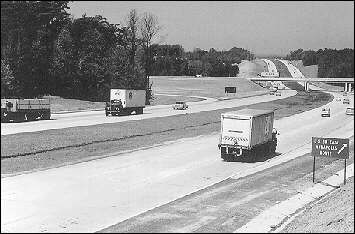
"Together, the united forces of our communication and transportation systems are dynamic elements in the very name we bear - United States. Without them, we would be a mere alliance of many separate parts."
- President Dwight D. Eisenhower, Feb. 22, 1955
By the late 1930s, the pressure for construction of transcontinental superhighways was building. It even reached the White House, where President Franklin D. Roosevelt repeatedly expressed interest in construction of a network of toll superhighways as a way of providing more jobs for people out of work.
He thought three east-west and three north south routes would be sufficient. Congress, too, decided to explore the concept. The Federal-Aid Highway Act of 1938 directed the chief of the Bureau of Public Roads (BPR) to study the feasibility of a six route toll network. The resultant two-part report, Toll Roads and Free Roads, was based on the statewide highway planning surveys and analysis.
Part I of the report asserted that the amount of transcontinental traffic was insufficient to support a network of toll superhighways. Some routes could be self-supporting as toll roads, but most highways in a national toll network would not.
Part II, "A Master Plan for Free Highway Development," recommended a 43,000-kilometer (km) nontoll interregional highway network. The interregional highways would follow existing roads wherever possible (thereby preserving the investment in earlier stages of improvement). More than two lanes of traffic would be provided where traffic exceeds 2,000 vehicles per day, while access would be limited where entering vehicles would harm the freedom of movement of the main stream of traffic.
Within the large cities, the routes should be depressed or elevated, with the former preferable. Limited-access belt lines were needed for traffic wishing to bypass the city and to link radial expressways directed toward the center of the city. Inner belts surrounding the central business district would link the radial expressways while providing a way around the district for vehicles not destined for it.
On April 27, 1939, Roosevelt transmitted the report to Congress. He recommended that Congress consider action on:
[A] special system of direct interregional highways, with all necessary connections through and around cities, designed to meet the requirements of the national defense and the needs of a growing peacetime traffic of longer range.
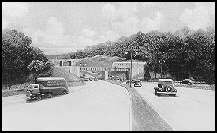
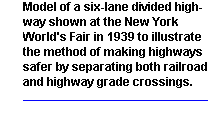
The president's political opponents considered the "master plan" to be "another ascent into the stratosphere of New Deal jitterbug economics," as one critic put it. Overall, however, reaction was favorable within the highway community although some observers thought the plan lacked the vision evident in the popular "Futurama" exhibit at the 1939 New York World's Fair.
The exhibit's designer, Norman Bel Geddes, imagined the road network of 1960 - 14-lane superhighways crisscrossing the nation, with vehicles moving at speeds as high as 160 km per hour. Radio beams in the cars regulated the spacing between them to ensure safety. In the cities, traffic moved on several levels - the lowest for service, such as pulling into parking lots, the highest for through traffic moving 80 km per hour. Although the "magic motorways" shown in Futurama were beyond the technological and financial means of the period, they helped popularize the concept of interstate highways.
With America on the verge of joining the war under way in Europe, the time for a massive highway program had not arrived. However, the president was already thinking about the post-war period. He feared resumption of the Depression if American soldiers returned from the war and were unable to find jobs. A major highway program could be part of the answer.
On April 14, 1941, the president appointed a National Interregional Highway Committee to investigate the need for a limited system of national highways. Thomas H. MacDonald, BPR chief, chaired the committee and appointed Herbert S. Fairbank, BPR's Information Division chief, as secretary.
Interregional Highways, written by Fairbank and released on Jan. 14, 1943, refined the concepts introduced in Part II of Toll Roads and Free Roads. The new report recommended an interregional highway system of 63,000 km, designed to accommodate traffic 20 years from the date of construction.
The report went into detail on urban freeways. MacDonald and Fairbank were convinced that these freeways would exert a powerful force on the shape of the future city. It was important, therefore, for the network to be located so as to "promote a desirable urban development."
As consideration of the Federal-Aid Highway Act of 1944 began, the highway community was divided. Rival apportionment formulas divided the states. Urban interests battled rural interests for priority. And states sought increased authority from the federal government. The result of these disagreements was an inability to agree on the major changes needed in the post-war era to address accumulated highway needs. The Federal-Aid Highway Act of 1944 primarily maintained the status quo. Its biggest departure was in Section 7, which authorized designation of a 65,000-km "National System of Interstate Highways," to be selected by joint action of the state highway departments:
... so located as to connect by routes, as direct as practicable, the principal metropolitan areas, cities, and industrial centers, to serve the national defense, and to connect at suitable border points with routes of continental importance in the Dominion of Canada and the Republic of Mexico.
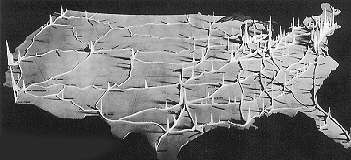
Although Section 7 authorized the interstate system, it included no special provisions to give the interstate highways a priority based on their national importance. Section 7 did not authorize special funding, increase the federal share, or make a federal commitment to construct the system.
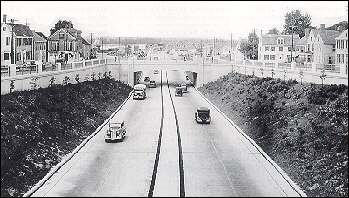
The Public Roads Administration (PRA), as the BPR was now called, moved quickly to implement Section 7. It called on the states to submit recommendations on which routes should be included in the interstate system. PRA also began working with state and local officials to develop interstate plans for the larger cities. In addition, PRA worked with the American Association of State Highway Officials (AASHO) to develop design standards for the interstate system.
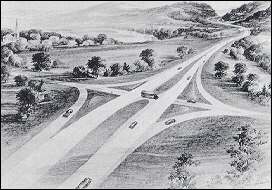
These standards, approved Aug. 1, 1945, did not call for a uniform design for the entire system, but rather for uniformity where conditions such as traffic, population density, topography, and other factors were similar. Designs, which would be based on traffic expected 20 years from the date of construction, would be adjusted to conditions. Most segments would have at least four lanes and full control of access would be provided where permitted by state law. But two-lane segments, limited access control, and at-grade railroad and highway crossings would be permitted where warranted by low traffic volumes.
On Aug. 2, 1947, PRA announced designation of the first 60,640 km of interstate highways, including 4,638 km of urban thoroughfares. PRA reserved 3,732 km for additional urban circumferential and distributing routes that would be designated later.
Construction of the interstate system moved slowly. Many states did not wish to divert federal-aid funds from local needs. Others complained that the standards were too high. Some of the heavily populated states, finding that federal-aid funding was so small in comparison with need, decided to authorize construction of toll roads in the interstate corridors. Also, by July 1950, the United States was again at war, this time in Korea, and the focus of the highway program shifted from civilian to military needs.
The Federal-Aid Highway Act of 1952 authorized $25 million for the interstate system on a 50-50 matching basis. These were the first funds authorized specifically for interstate construction. However, it was a token amount, reflecting the continuing disagreements within the highway community rather than the national importance of the system.
When President Dwight D. Eisenhower took office in January 1953, the states had completed 10,327 km of system improvements at a cost of $955 million - half of which came from the federal government. According to BPR, as it was again called, only 24 percent of interstate roadway was adequate for present traffic; that is, very little of the distance had been reconstructed to meet traffic expected 20 years hence.
Long before taking office, Eisenhower recognized the importance of highways.
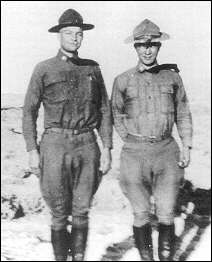
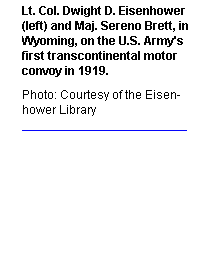
His first realization of the value of good highways occurred in 1919, when he participated in the U.S. Army's first transcontinental motor convoy from Washington, D.C., to San Francisco.
When Eisenhower and a friend heard about the convoy, they volunteered to go along as observers, "partly for a lark and partly to learn," as he later recalled. On the way west, the convoy experienced all the woes known to motorists and then some - an endless series of mechanical difficulties; vehicles stuck in mud or sand; trucks and other equipment crashing through wooden bridges; roads as slippery as ice or dusty or the consistency of "gumbo"; extremes of weather from desert heat to Rocky Mountain freezing; and, for the soldiers, worst of all, speeches, speeches, and more speeches in every town along the way.
On Sept. 5, 1919, after 62 days on the road, the convoy reached San Francisco, where it was greeted with medals, a parade, and more speeches.
During World War II, Gen. Eisenhower saw the advantages Germany enjoyed because of the autobahn network. He also noted the enhanced mobility of the Allies when they fought their way into Germany.
These experiences shaped Eisenhower's views on highways. "The old convoy," he said, "had started me thinking about good, two-lane highways, but Germany had made me see the wisdom of broader ribbons across the land."
In 1953, the first year of the Eisenhower administration, the president had little time for highways. He was preoccupied with bringing an end to the war in Korea and helping the country get through the economic disruption of the post-war period.
However, 1954 was a year in which a new federal-aid highway act would be needed, and from the start, during the State of the Union Address on Jan. 7, Eisenhower made clear that he was ready to turn his attention to the nation's highway problems. He considered it important to "protect the vital interest of every citizen in a safe and adequate highway system."
Having held extensive hearings in 1953, Congress was able to act quickly on the Federal-Aid Highway Act of 1954.
Again, however, Congress avoided radical departures that would alter the balance among competing interests. All the programs, including the interstate system, were funded at higher levels, so each of the interests was satisfied. The main controversy involved the apportionment of the funds. Heavily populated states and urban areas wanted population to be the main factor, while other states preferred land area and distance as factors.
The 1954 bill authorized $175 million for the interstate system, to be used on a 60-40 matching ratio. The formula represented a compromise: one-half based on population and one-half based on the federal-aid primary formula (one-third on roadway distance, one-third on land area, and one-third on population).
During the signing ceremony at the White House on May 6, 1954, the president said, "This legislation is one effective forward step in meeting the accumulated needs." But he knew it was not a big enough step, and he decided to do something about it.
Eisenhower planned to address a conference of state governors in Bolton Landing on Lake George, N.Y., July 12, 1954. Because of the death of his sister-in-law, the president was unable to attend, and Vice President Richard M. Nixon delivered the message from detailed notes the president had prepared.
Nixon told the governors that the increased funding authorized earlier that year was "a good start" but "a $50 billion highway program in 10 years is a goal toward which we can - and we should - look." Such a program, over and above the regular federal-aid program, was needed because "... our highway network is inadequate locally, and obsolete as a national system."
The vice president read the president's recollection of his 1919 convoy, then cited five "penalties" of the nation's obsolete highway network: the annual death and injury toll, the waste of billions of dollars in detours and traffic jams, the clogging of the nation's courts with highway-related suits, the inefficiency in the transportation of goods, and "the appalling inadequacies to meet the demands of catastrophe or defense, should an atomic war come."
What was needed, the president believed, was a grand plan for a properly articulated system of highways. The president wanted a self-liquidating method of financing that would avoid debt. He wanted a cooperative alliance between state and federal officials to accomplish the federal part of the grand plan. And he wanted the federal government to cooperate with the states to develop a modern state highway system.
Finally, the vice president read the last sentence of the president's notes, in which he asked the governors to study the matter and recommend the cooperative action needed to meet these goals.
The speech, according to a contemporary observer, had an "electrifying effect" on the conference. It had come as a complete surprise, without the advance work that usually precedes major presidential statements. Furthermore, the speech was delivered at a time when the governors were again debating how to convince the federal government to stop collecting gas taxes so the states could pick up the revenue. Some governors even argued that the federal government should get out of the highway business altogether.
Within the administration, the president placed primary responsibility for developing a financing mechanism for the grand plan on retired Gen. Lucius D. Clay, an engineer and a long-time associate and advisor to the president. At the time, Clay was chairman of the board of the Continental Can Company. The President's Advisory Committee on a National Highway Program, commonly called the "Clay Committee," included Steve Bechtel of Bechtel Corporation, Sloan Colt of Bankers' Trust Company, Bill Roberts of Allis-Chalmers Manufacturing Company, and Dave Beck of the International Brotherhood of Teamsters.
Francis C. (Frank) Turner of BPR was appointed to serve as the advisory committee's executive secretary. Turner was an excellent choice because, unlike the members of the Clay Committee, he had direct knowledge of highway finance and construction, gained through a career that began when he joined BPR in 1929. He also had a direct link to the data resources of BPR.
Gen. Clay and his committee members quickly found themselves confronted with the usual range of alternatives - from inside and outside the administration - that had bedeviled debates on the National System of Interstate Highways from the start.
By the end of the year, however, the Clay Committee and the governors found themselves in general agreement on the outline of the needed program. The governors had concluded that, as a practical matter, they could not get the federal government out of the gas tax business. Instead, they submitted proposals that, among other things, would keep state matching requirements at about current levels.
Based on BPR data, the Clay Committee's report estimated that highway needs totaled $101 billion. The governors' report had indicated that the federal share of total needs should be about 30 percent, including the federal share of the cost of the interstate system. BPR estimated that the cost of modernizing the designated 60,670 km in 10 years would be $23 billion.
The committee made a rough estimate of $4 billion for the urban roads that had not yet been designated. This figure, $27 billion, was accepted by all parties as the goal of any plan for financing the interstate highways. Because the interstate system "is preponderantly national in scope and function," the report recommended that the federal government pay most of the cost of its construction. The state and local share would be about $2 billion.
To finance the system, the Clay Committee proposed creation of a Federal Highway Corporation that would issue bonds worth $25 billion. Revenue from gas taxes would be dedicated to retiring the bonds over 30 years. Because traffic would continue to increase during that period, revenue would also go up, and a hike in the gas tax would not be necessary.
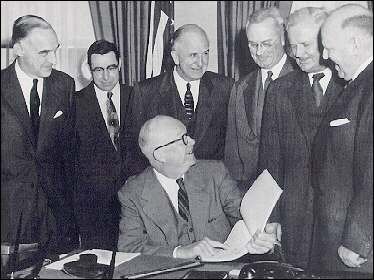
Eisenhower forwarded the Clay Committee's report to Congress on Feb. 22, 1955. In his transmittal letter, he acknowledged the "varieties of proposals which must be resolved into a national highway pattern," and he wrote that the Clay Committee's proposal would "provide a solid foundation for a sound program." Furthermore, he said:
Our unity as a nation is sustained by free communication of thought and by easy transportation of people and goods. The ceaseless flow of information throughout the republic is matched by individual and commercial movement over a vast system of interconnected highways crisscrossing the country and joining at our national borders with friendly neighbors to the north and south.
Together, the united forces of our communication and transportation systems are dynamic elements in the very name we bear - United States. Without them, we would be a mere alliance of many separate parts.
Even before the President transmitted the report to Congress, Sen. Albert Gore Sr. of Tennessee, chairman of the Subcommittee on Roads in the Committee on Public Works, introduced his own bill. As modified before going to the Senate for consideration, the Gore bill proposed to continue the federal-aid highway program, but with $10 billion for the interstate system through fiscal year (FY) 1961. The limitation would be increased to 68,400 km, and the federal share for interstate projects would be 75 percent.
One of the biggest obstacles to the Clay Committee's plan was Sen. Harry Flood Byrd of Virginia, chairman of the Committee on Finance that would have to consider the financing mechanisms for the program. Byrd never wavered in his opposition to bond financing for the grand plan. He was a pay-as-you-go man, who was described by biographer Alden Hatch as having "an almost pathological abhorrence for borrowing that went beyond reason to the realm of deep emotion."
Byrd objected to restricting gas tax revenue for 30 years to pay off the debt. He objected to paying $12 billion in interest on the bonds. He objected to the fact that the corporation's debt would be outside the public debt and beyond congressional control. He also objected to other features of the Clay Committee's proposal, including the proposal to provide credit - a windfall - for toll roads and toll-free segments already built.
By contrast, the Gore bill had many positive elements, but it had one glaring deficiency. Because the U.S. Constitution specifies that revenue legislation must originate in the House of Representatives, the Gore bill was silent on how the revenue it authorized would be raised. The House Ways and Means Committee would have to fill in the details.
On May 25, 1955, the Senate defeated the Clay Committee's plan by a vote of 60 to 31. The Senate then approved the Gore bill by a voice vote that reflected overwhelming support, despite objections to the absence of a financing plan.
Rep. George H. Fallon of Baltimore, Md., chairman of the Subcommittee on Roads in the House Committee on Public Works, knew that even if the House approved the Clay Committee plan, it would stand little chance of surviving a House-Senate conference. He, therefore, drafted a new bill with the help of data supplied by Frank Turner.
Through a cooperative arrangement with the Ways and Means Committee, Fallon's bill included highway user tax increases with the revenue informally committed to the program. The interstate system would be funded through FY 1968 with a federal share of 90 percent. Because of the significance of the interstate system to national defense, Fallon changed the official name to the "National System of Interstate and Defense Highways." This new name remained in all future House versions and was adopted in 1956.
By a vote of 221 to 193, the House defeated the Clay Committee's plan on July 27, 1955. That was not a surprise. What was a surprise was that Fallon's bill, as modified in committee, was defeated also. It lost by an even more lopsided vote of 292 to 123. Most observers blamed the defeat of the Fallon bill on an intense lobbying campaign by trucking, petroleum, and tire interests. Speaker of the House Sam Rayburn told reporters, "The people who were going to have to pay for these roads put on a propaganda campaign that killed the bill."
Congress adjourned a few days later, ending consideration of the highway program for the year.
On Jan. 5, 1956, in his State of the Union Address, the president renewed his call for a "modern, interstate highway system." At first glance, prospects for bipartisan agreement on the highway program seemed slim in 1956, a presidential election year. But changes had been occurring that would turn the situation around in 1956.
One of the important changes was BPR's designation of the remaining 3,500 km of the interstate system, all of it in urban areas, in September 1955. BPR also published General Location of National System of Interstate Highways, which became known as "The Yellow Book" because of the color of its cover.
It contained a map of the interstate system as designated in August 1947 plus maps of 100 urban areas showing where designated interstate roadway would be located. A copy of The Yellow Book was provided to each member of Congress as a way of emphasizing the importance of the interstate system to the nation's urban areas.
At the same time, the highway interests that had killed the Fallon bill in 1955 were reassessing their views and clarifying their concerns. One important change, for example, occurred when trucking industry representatives indicated they were not opposed to all tax increases, only to the tax increases proposed in the Fallon bill, which they thought made them bear an unfair share of the load. They would agree to a one or two-cent hike in gas taxes and increases in certain other taxes.
Other groups that had assumed the Fallon bill would pass and had, therefore, not actively lobbied Congress in support of the bill, increased their efforts in support of legislation in 1956.
Because the Senate had approved the Gore bill in 1955, the action remained in the House. Fallon introduced a revised bill, the Federal Highway Act of 1956, on Jan. 26, 1956. It provided for a 65,000-km national system of interstate and defense highways to be built over 13 years. The federal share would be 90 percent or $24.8 billion. Increased funding would be provided for the other federal-aid highway systems as well.
Interstate funds would be apportioned on a cost-to-complete basis; that is, the funds would be distributed in the ratio which each state's estimated cost of completing the system bears to the total cost of completing the system in all states. The ratio would be determined on the basis of cost estimates prepared by BPR.
The 1956 Fallon bill would be financed on a pay-as-you-go basis, but the details had not yet been worked out by the House Ways and Means Committee. However, even before the details were announced, the president endorsed the pay-as-you-go method on Jan. 31, 1956, thereby recognizing that the Clay Committee's plan was dead. Years later, Eisenhower would recall:
Though I originally preferred a system of self-financing toll highways, and though I endorsed General Clay's recommendations, I grew restless with the quibbling over methods of financing. I wanted the job done.
On March 19, the House Ways and Means Committee reported out a bill, developed by Rep. Hale Boggs of Louisiana, that contained the financing mechanism. The Highway Revenue Act of 1956 proposed to increase the gas tax from two to three cents per gallon and to impose a series of other highway user tax changes. Acting on a suggestion by Secretary of Treasury George Humphrey, Rep. Boggs included a provision that credited a revenue from highway user taxes to a Highway Trust Fund to be used for the highway program.
The Committee on Public Works combined the Fallon and Boggs bills as Title I and Title II, respectively, of a single bill that was introduced on April 21. On April 27, the Federal Highway Act of 1956 passed the House by a vote of 388 to 19.
The bill was sent to the Senate, which referred the two titles to different committees for consideration. The Public Works Committee removed the program portion of the House bill and substituted the Gore bill with some changes.
Two major changes were that, like the Fallon bill, the new version established a 13-year program for completing the interstate system and the 1956 version adopted the funding level and the 90-10 matching ratio approved by the House. A key difference with the House bill was the method of apportioning interstate funds; the Gore bill would apportion two-thirds of the funds based on population, one-sixth on land area, and one-sixth on roadway distance.
Byrd's Committee on Finance largely accepted the Boggs bill as the financing mechanism for the interstate system and the federal-aid highway program. Byrd responded to a concern expressed by the secretary of the treasury that funding levels might exceed revenue by inserting what has since become known as the Byrd Amendment. It provided that if the secretary of the treasury determines that the balance in the Highway Trust Fund will not be enough to meet required highway expenditures, the secretary of commerce is to reduce the apportionments to each of the states on a pro rata basis to eliminate this estimated deficiency.
On May 28 and 29, the Senate debated the Federal-Aid Highway Act of 1956 before approving it by a voice vote. The House and Senate versions now went to a House-Senate conference to resolve the differences. The conference was difficult as participants attempted to preserve as much of their own bill as possible. On June 25, the conferees completed their work.
The Federal-Aid Highway Act of 1956 that emerged from the House-Senate conference committee included features of the Gore and Fallon bills, as well as compromises on other provisions from both.
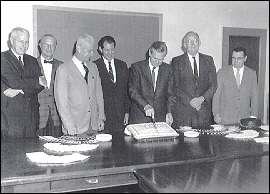
The interstate system was expanded, but only by 1,600 km to 66,000 km. To construct the network, $25 billion was authorized for FYs 1957 through 1969. During the first three years, the funds would be apportioned as provided for in the Gore bill (mileage, land area, and population). In succeeding years, apportionments would be made on the cost-to-complete basis provided for in the Fallon bill. The added 1,600 km were excluded from the estimate. The federal share of project costs would be 90 percent.
The 1956 act called for uniform interstate design standards to accommodate traffic forecast for 1975 (modified in later legislation to traffic forecast in 20 years). BPR would work with AASHO to develop minimum standards that would ensure uniformity of design, full control of access, and elimination of highway and railroad-highway grade crossings.
Two lane segments, as well as at-grade intersections, were permitted on lightly traveled segments. (However, legislation passed in 1966 required all parts of the interstate highway system to be at least four lanes with no at-grade intersections regardless of traffic volume.)
Access would be limited to interchanges approved as part of the original design or subsequently approved by the secretary of commerce. Service stations and other commercial establishments were prohibited from the interstate right-of-way, in contrast to the franchise system used on toll roads.
The act prohibited the secretary from apportioning funds to any state permitting excessively large vehicles - those greater in size or weight than the limits specified in the latest AASHO policy or those legally permitted in a state on July 1, 1956, whichever were greater - to use the interstate highways. In addition, the secretary was directed to conduct a study of highway costs and of how much each class pays toward those costs in relation to the cost attributable to it.
Federal-aid funds could be used to advance acquisition of right-of way. Because some states did not yet have the authority to legally acquire control of access, the secretary could, at the request of a state, acquire the right-of-way and convey title to the state.
Toll roads, bridges, and tunnels could be included in the system if they met system standards and their inclusion promoted development of an integrated system. This provision avoided the costly alternative of constructing toll-free interstate routes in corridors already occupied by turnpikes. The 1956 act deferred a decision on the controversial issue of whether to reimburse states for turnpikes and toll-free segments built with less than 90-percent interstate funding or no funding. Instead, the secretary was directed to study the issue and report to Congress. (Congress did not approve reimbursement until the passage of the Intermodal Surface Transportation Efficiency Act of 1991.)
The 1956 act also resolved one of the most controversial issues by applying the Davis-Bacon Act to interstate construction projects, despite concerns that the cost of the projects would be increased. The Davis Bacon Act, which had been enacted in the 1930s, required that federal construction projects pay no less than the prevailing wages in the immediate locality of the project. It had not previously applied to federal-aid projects, which were state, not federal, projects.
On June 26, 1956, the Senate approved the bill by a vote of 89 to 1. (The one "no" vote was cast by Sen. Russell Long of Louisiana who opposed the gas tax increase.) That same day, the House approved the bill by a voice vote.
Earlier that month, Eisenhower had entered Walter Reed Army Medical Center after an attack of ileitis, an intestinal ailment. He was still in the hospital on June 29, when a stack of bills was brought in for signature. One of them was the Federal-Aid Highway Act of 1956, the landmark bill for which he had fought so hard. He signed it without ceremony or fanfare. White House Press Secretary James C. Hagerty told the press that the president "was highly pleased."
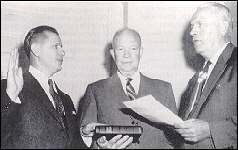
Secretary of Commerce Sinclair Weeks immediately announced the allocation of $1.1 billion to the states for the first year of what he called "the greatest public works program in the history of the world."
To manage the program, Eisenhower chose Bertram D. Tallamy to head BPR, with the newly authorized title "Federal Highway Administrator." Tallamy, who was New York's superintendent of public works and chairman of the New York State Thruway Authority, would not be available until early 1957. John A. Volpe, who had been the commissioner of public works in Massachusetts for four years, served as interim administrator from Oct. 22 until Tallamy could take office in February 1957.
In August 1957, AASHO announced the numbering scheme for the interstate highways and unveiled the red, white, and blue interstate shield. Many of the states had submitted proposals for the shield, but the final version was a combination of designs submitted by Missouri and Texas. Administrator Tallamy approved the route marker and the numbering plan in September.
And so, construction of the interstate system was under way.
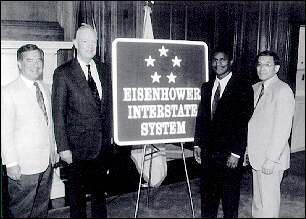
In October 1990, President George Bush - whose father, Sen. Prescott Bush of Connecticut, had been a key supporter of the Clay Committee's plan in 1955 - signed legislation that changed the name of the system to the "Dwight D. Eisenhower System of Interstate and Defense Highways." This change acknowledged Eisenhower's pivotal role in launching the program. The key elements that constituted the interstate highway program - the system approach, the design concept, the federal commitment, and the financing mechanism - all came together under his watchful eye.
Biographer Stephen E. Ambrose stated, "Of all his domestic programs, Eisenhower's favorite by far was the Interstate System." Eisenhower's 1963 memoir, Mandate for Change 1953-1956, explained why:
More than any single action by the government since the end of the war, this one would change the face of America. ... Its impact on the American economy - the jobs it would produce in manufacturing and construction, the rural areas it would open up - was beyond calculation.
The next 40 years would be filled with unexpected engineering challenges, unanticipated controversies, and unforeseen funding difficulties. Nevertheless, the president's view would prove correct. The interstate system, and the federal-state partnership that built it, changed the face of America.
References
1. America's Highways 1776-1976, Federal Highway Administration, Washington, D.C., 1976.
2. Mark H. Rose. Interstate Express Highway Politics 1941-1989, University of Tennessee Press, 1990 (Revised Edition).
3. Gary T. Schwartz. "Urban Freeways and the Interstate System," Southern California Law Review 49 (March 1976), pp. 406-513.
4. Bruce E. Seely. Building the American Highway System: Engineers as Policy Makers, Temple University Press, Philadelphia, Pa., 1987.

Richard F. Weingroff is an information liaison specialist in the Federal Highway Administration�s Office of the Associate Administrator for Program Development.
| Turner-Fairbank Home | FHWA Home | Feedback | Index |
Go to the Public Roads Website